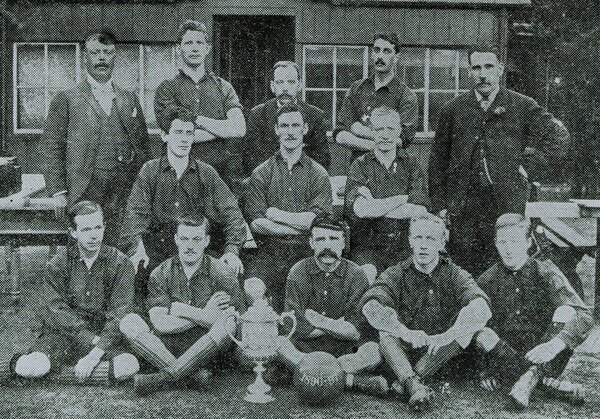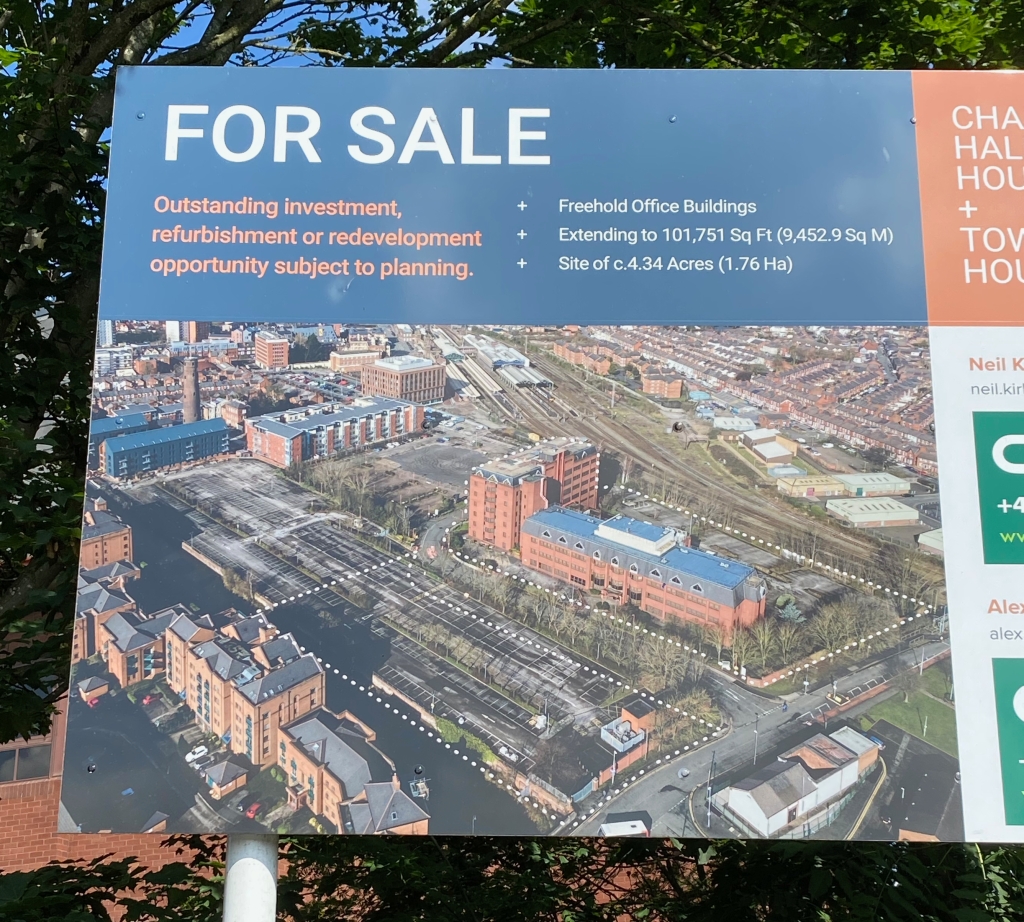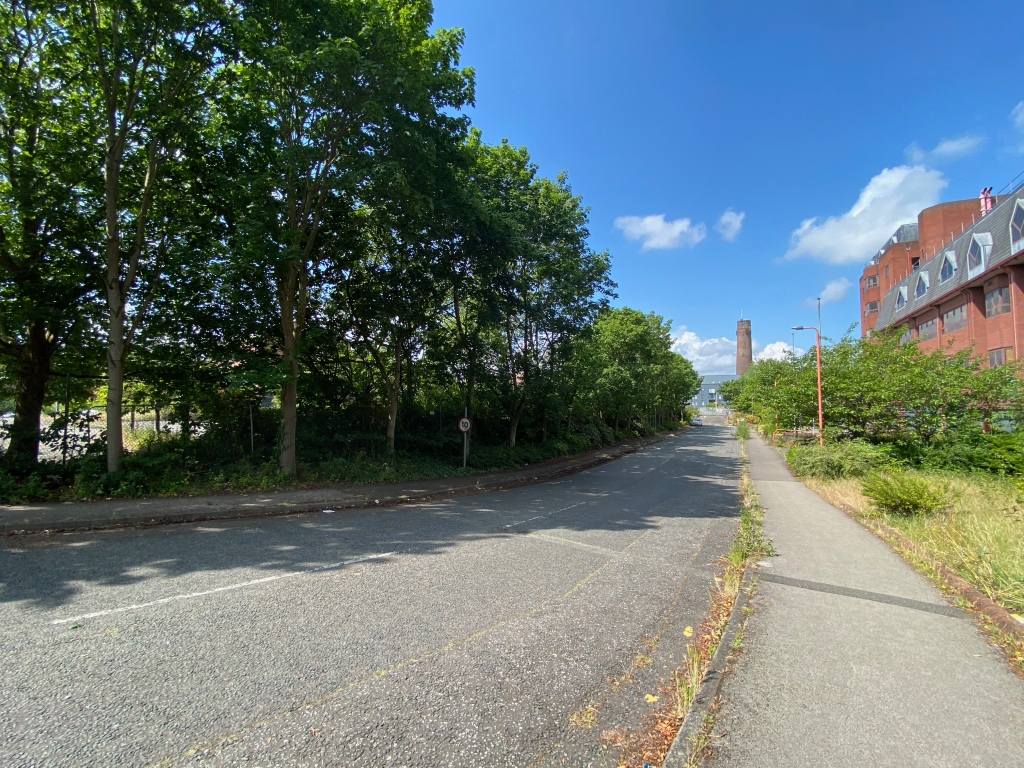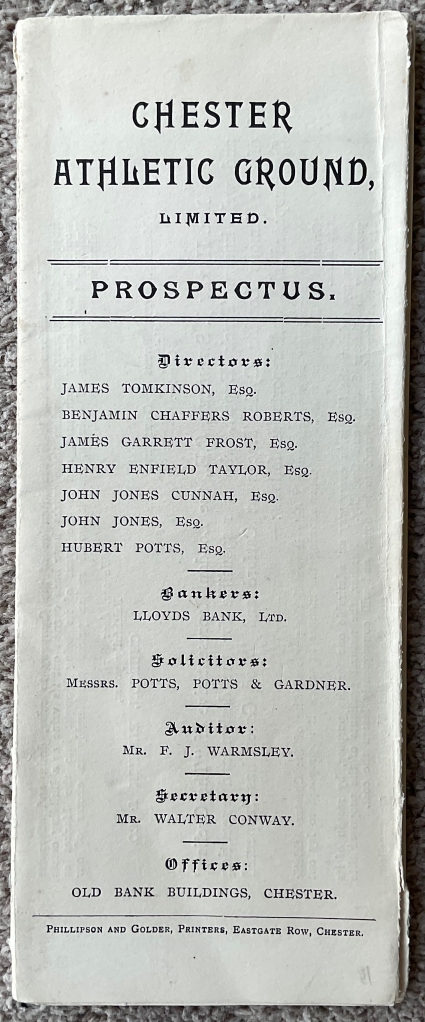At the end of the 19th century the large scale housebuilding in Hoole was beginning to encroach on Chester’s ground in Faulkner Street and it became clear that a new home would be needed if the club was to continue. One of the options was the nearby Lead Works Field sandwiched between the Shropshire Union canal and the railway line. In the end the plan, for an all purpose athletics field, never got off the ground but had the project gone through it could have altered the whole history of the club..
The completion of the 1896/97 season saw Chester Football Club in turmoil, not for the first or last time. The club seemed to be drifting along aimlessly with no committee meetings taking place and it was essentially being run by the secretary and players. No accounts had been produced for several weeks and the debts were mounting while the players, who had been unpaid, were refusing to continue into the new season if the current committee was still in place. On top of all this the Faulkner Street ground itself was becoming a major headache as new housing edged ever closer. Ironically, all this upheaval came at a time when the club was achieving some success on the field of play having just won the Cheshire Senior Cup for a second time. Such were the internal problems that a couple of the players refused to appear in the team photograph taken with the cup at the end of the campaign.

The formation of a new committee during the summer saw some sense of normality return to the club although they controversially refused to take on the debt overseen by the previous regime. One of the reasons for adopting this stance must have been the costs involved in preparing for the forthcoming 1897/98 campaign. The landlord of the Faulkner Street ground wanted to increase the rent but the club also faced the prospect of moving the hoardings closer to the pitch at a cost of £50, a move which would only have been a temporary measure. The alternative was to find a new ground with two or three options available. A field by the Lead Works looked the most viable choice but in the end the club decided to remain where they were for another season as it was felt that the cost implications of erecting new hoardings, moving and levelling the pitch were even more prohibitive than staying where they were.
Nevertheless the Lead Works Field looked an attractive option for sport and in April 1898 a share prospectus was issued by a new company called the Chester Athletic Ground Limited. They proposed issuing 700 shares at £10 each in order to purchase the land and fund a high class athletic ground adapted and equipped for a range of sports and pastimes. The company estimated that their ambitious venture would cost around £8,800 with the balance met through mortgaging the property.

Although the football club was not directly involved they had come to an agreement with the Athletic Company to play their matches at the ground and were a key component if the scheme was to succeed.
The men behind the company were all prominent figures in the area. The chairman, James Tomkinson, was a bank director who owned Willington Hall near Tarporley and later went on to become Liberal MP for Crewe until his death in 1910. Others involved included Benjamin Chaffers Roberts, a retired tea merchant who had built and lived at Oakfield house, which now stands at the heart of Chester Zoo. Another director was James Frost, a corn miller and JP who lived at Boughton Hall while other directors included solicitor Hubert Potts, Land Agent John Cunnah and Civil Engineer Henry Taylor.
While football was important to the pioneering project the main focus was on cycling which was going through a boom period with new technology seeing a surge in activity. The introduction of the “safety bicycle” with equal, smaller sized wheels as well as the inflatable tyre both helped fuel this interest. The local papers had regular columns on the sport and the Faulkner Street ground had hosted the first race meeting of Chester Cycling Club which attracted more than 1000 people on a Wednesday evening in July 1897.
The scale and range of the project was certainly ambitious because as well as football and cycling there were also plans to include a running track, inside the banked cycle track. In addition the prospectus also mentioned lawn tennis courts for the summer as well as cricket and croquet alongside horticultural and other shows and entertainments.
The prospectus highlighted the proximity of Chester General Station which was “less than five minutes walk” away with access from City Road down what is now Queen’s Road. From the other direction there would have been entrances by the canal bridge on the junction between Station View Road and Hoole Lane. Part of the proposed site is now covered by the extension to Westminster Road which has by-passed Station View Road and made it into a cul-de-sac.

Within the prospectus it was suggested that the ground would hold 20,000 people and as well as stands, dressing and bath rooms there would also be other recreation and amusement facilities.
Despite the best intentions and high profiles of the people involved the project never got off the ground and the share application only realised around £4,000 of the £7,000 needed. One of the drawbacks is that the price of £10 a share was felt to be well out of the range of the working man and it was felt that there might have been a better take-up if they had been priced at a more reasonable £1. Meanwhile the men behind the Chester Athletic Ground company had come to the conclusion that the ground was not large enough to make it pay and it is difficult to see how they could have accommodated the suggested number of spectators in the limited space after a football pitch, cycle track and athletics track had been installed.
As far as the football club was concerned it seems that it was more a case of jumping at the only opportunity available. The imminent loss of the Faulkner Street enclosure created a sense of urgency and purchasing and converting the Lead Works Field would have been outside Chester’s financial capabilities. Having someone else construct a ground and then renting it from them would have been an ideal solution but the football side of the project seems to have been of secondary importance to the cycle track. It is hard to believe that the ground would have been suitable for watching football with spectators a long way from the action and I’m sure the drawbacks of sharing a ground with multiple sports would have soon become problematical. It certainly wouldn’t have been a long term solution.
In the event Chester were forced to vacate Faulkner Street in 1898 and decamped a few hundred yards down the road to what was only a temporary home at the Old Showground in the Panton Road and Vicarage Road area of Hoole. That ground only existed for one season when housing again took over and for two seasons the club temporarily disbanded before emerging on the other side of the city on Whipcord Lane in 1901.
As an afterthought I went down to the area to see if I could get a couple of photographs to accompany the article. The old Lead Works Field is currently covered by two derelict office blocks and an overgrown car park and is for sale although the area available is now 4.34 acres. It did occur to me that if there are any multi-millionaires with money to burn and a huge amount of imagination it would still make a terrific but impractical site for a Stadium, minus a cycle and running track of course.






Hi Chas,
Fascinating read as always. I am a third year sport journalism student at Chester University, and as part of my project I am covering Chester FC. I would love to pick your brains regarding the history of the club. Let me know if this is something that would interest you. All the best, Brandon Smith